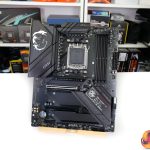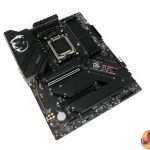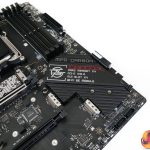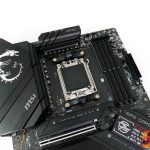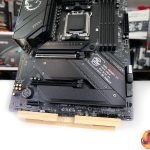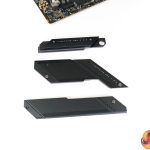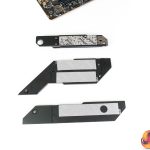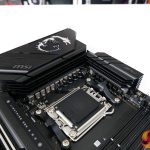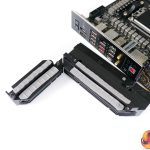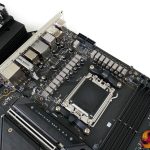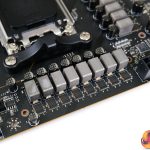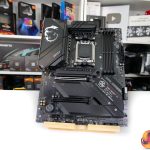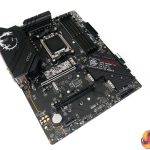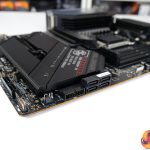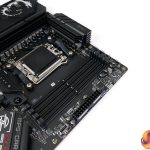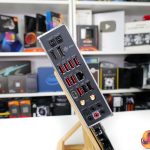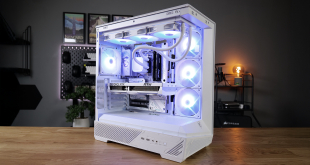Appearance-wise, this £380 ATX motherboard is styled very well in my opinion. The main colouring is largely dark black, but there are sprinkles of colour via MSI’s logos and branding.
One really cool design decision is the inclusion of ports bandwidth and connectivity on the chipset heatsink. Functionally, I’d argue that this piece of styling is very good; I like it!
Regarding heatsinks, MSI has gone for the big-and-beefy approach. A large slab of metal covers the B650 chipset and this also acts as the hub for some of the M.2 metal strips to be screwed into.
You get an individual strip cooler for the uppermost M.2 SSD slot with thermal pads on both sides. I like this design because it is tool-less through-and-through. As is now common, the SSD can be secured via a tool-less latch. But the heatsink can also be removed by pushing a mechanism to free and pop it out of place.
The VRM heatsinks are two large blocks of metal that will aim to cool via their sheer size and heatpipe connection. MSI doesn’t make the best effort to increase surface area via fins but these should be absolutely stellar though, particularly with some airflow nearby. And a sizable rear IO cover sits atop the ports on blends into the VRM heatsink.
The B650 Carbon WiFi uses a 6-layer, 2oz copper PCB and feeds a CPU with dual-8-pin connectors.
The primary power delivery system is built around a 16+2+1 stage power delivery solution with Monolithic Power Systems hardware. This uses an MPS2123 / MP2857 PWM controller and there are MPS 2206 / MP87670 DrMOS power stages that are 80A rated.
This is a proficient power delivery setup from a hardware perspective.
The primary PCIe x16 slot is steel-reinforced for graphics card usage. This runs at PCIe Gen 4 x16 bandwidth, whereas the other full-length slot runs at Gen 4 x4 bandwidth.
We know single-GPU is the go-to these days. And that’s a good thing given that modern graphics cards with their ludicrous 4+ slot coolers will leave only the bottom PCIe 3.0 x1 slot accessible.
One clear missing feature is any form of quick or easy release latch or button for the PCIe graphics slot. This is genuinely a problem given the proximity of the PCIe slot tab to the large M.2 cooling plate. I’m disappointed by MSI’s lack of this feature on a £380 motherboard!
Regarding M.2 connections, that top slot runs at PCIe Gen 5 x4 from the CPU lanes. There are two more CPU-fed M.2 slots running at PCIe Gen 4 x4, and the fourth M.2 is PCIe Gen 4 x4 from the B650 chipset.
Onboard connectivity is an area where B650 comes in light versus X670. But MSI still offers plenty of options.
You get six SATA ports which I think is sensible for this market segment, though just the one 5Gbps USB header may cause a hiccup for some. The front panel USB-C header runs at 3.2 Gen 2 so is not uber speed – the 20Gbps port is on the rear IO.
Seven total fan headers is awesome, particularly with MSI’s smart distribution. And three addressable plus a single standard RGB header is ample.
MSI also includes some debug LEDs near the 24-pin which are ideal for troubleshooting. There are no onboard buttons, though, which is fine for this board’s audience.
Audio runs from the Realtek ALC4080 codec.
The rear IO is hefty with USB support. There are 9 total Type-A ports, 7 of which run at 10Gbps while the remaining pair runs as USB 2.0 for legacy connectivity. The single USB Type-C port is 20Gbps rated.
Wi-Fi 6E and Bluetooth 5.2 is delivered by the AMD-branded WiFi chipset, while 2.5Gb Ethernet is from a Realtek RTL8125 NIC.
MSI provides the full complement of audio outputs in addition to full-sized DisplayPort 1.4 and HDMI 2.1.
Sizable BIOS Flash and Clear CMOS buttons on the rear IO are two features I love to see.
 KitGuru KitGuru.net – Tech News | Hardware News | Hardware Reviews | IOS | Mobile | Gaming | Graphics Cards
KitGuru KitGuru.net – Tech News | Hardware News | Hardware Reviews | IOS | Mobile | Gaming | Graphics Cards


